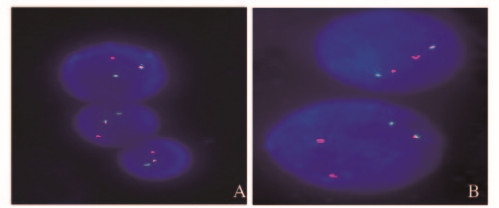扩展功能
文章信息
- 董洁, 李薇, 白晶, 林海, 刘春水, 韩薇, 胡瑞萍, 崔久嵬
- DONG Jie, LI Wei, BAI Jing, LIN Hai, LIU Chunshui, HAN Wei, HU Ruiping, CUI Jiuwei
- 9号衍生染色体在慢性粒细胞白血病预后评估中的意义
- Significance of derivative chromosome 9 in evaluation on prognosis of chronic myeloid leukemia
- 吉林大学学报(医学版), 2016, 42(02): 301-305
- Journal of Jilin University (Medicine Edition), 2016, 42(02): 301-305
- 10.13481/j.1671-587x.20160221
-
文章历史
- 收稿日期: 2015-11-04
慢性粒细胞白血病(chronic myeloid leukemia,CML)是一种发生在早期多功能造血干细胞上的恶性骨髓增生性疾病(获得性造血干细胞恶性克隆性疾病),其病程从数月到10余年不等,相关不良因素的研究显得尤为重要。有研究[1, 2, 3]表明:9号衍生染色体与CML不良预后相关,亦有研究[4, 5]未发现其与CML的不良预后存在相关性。9号衍生染色体与CML治疗效果及预后存在相关性的研究结果尚存在争议,且近期的相关研究较少。本研究通过检测精氨酸琥珀酸合成酶(argininosuccinate synthetase,ASS)基因的方法来达到检测9号衍生染色体的目的,并进一步探讨9号衍生染色体在CML预后评估中的可能作用。
1 资料与方法 1.1 研究对象收集2005年12月-2014年5月于吉林大学第一医院肿瘤中心收治的BCR-ABL融合基因阳性的34例曾进行过ASS基因检测的CML患者的资料进行回顾性分析,统计数据截止时间至2015年2月。所有患者均经血液学、骨髓象、细胞遗传学及免疫学分型检查而确诊。CML的诊断依据张之南主编的《白血病诊断及疗效标准》(第2版)。其中男性23例,女性11例;中位年龄36岁(7~78岁);处于慢性期23例,处于急变期/加速期11例;应用酪氨酸激酶抑制剂(tyrosine kinase inhibitors,TKI)(伊马替尼、达希纳)治疗的患者26例,应用羟基脲和干扰素等传统化疗方案治疗的患者6例,未治疗2例。所有患者均进行了ASS基因检测。
1.2 标本采集采集患者骨髓,采用不加任何刺激剂的24 h短期培养法制备染色体,G显带进行核型分析。核型异常按照《人类细胞遗传学国际命名体制(ISCN2005)》进行描述。每例标本分析20个中期分裂相。每例标本的核型分析至少需经2个技术人员共同完成。剩余的细胞悬液保存在-20℃以下供荧光原位杂交(fluorescence in situ hybridization,FISH)检测。
1.3 检测方法所有病例均采用Extra-signal(ES)探针对骨髓间期细胞进行FISH检测,同时运用LSI 9q34探针检测9号衍生染色体有无部分序列缺失。所有探针均购自美国Vysis公司。LSI 9q34探针所针对的基因组靶点从ASS基因延伸至ABL基因着丝粒端,长约270 000 bp,为SpectrumAqua标记。按照试剂盒提供的FISH操作说明书进行操作,Zeiss Axioplan2荧光显微镜下观察杂交信号,用Isis荧光图像处理系统进行图像分析,每份FISH标本分析200个细胞,不计数重叠细胞。
1.4 结果判读GLP BCR探针覆盖主要断裂点以上的部分BCR基因,荧光信号为绿色;GLP ABL探针覆盖整个ABL基因及ASS基因,荧光信号为红色。小红色信号缺失即ASS基因缺失。
1.5 统计学分析采用SPSS16.0统计软件对数据进行统计学分析。患者急变率/加速率组间比较应用Fisher确切概率法。以α=0.05为检验水准。
2 结果 2.1 患者的一般特征本研究中患者中位随访时间为25个月(3.0~92.5个月),无失访,患者一般情况如表 1所示。经FISH检测所有患者的BCR-ABL融合信号均为阳性,34例患者中有6例(17.6%)患者存在ASS基因缺失。检测时,伴ASS基因缺失的患者处于慢性期1例,发展为急变期/加速期5例;而无ASS基因缺失的患者处于慢性期22例,发展为急变期/加速期6例,2组患者急变率/加速率比较差异有统计学意义(P=0.008)。见图 1(插页四)和表 1。
| Characteristic | n | Derivative chromosome 9 | P | |
| Yes | No | |||
| Gender | ||||
| Male Female | 21 13 | 3 3 | 18 10 | 0.653 |
| Age(year) | ||||
| ≥43 <43 | 16 18 | 3 3 | 13 15 | 1.000 |
| Treatment | ||||
| TKI | 26 | 5 | 21 | |
| Chemotherapy | 6 | 1 | 5 | 1.000 |
| No treatment | 2 | 0 | 2 | |
| Status | ||||
Chornic phase Blastic phase or accelerated phase | 23 11 | 1 5 | 22 6 | 0.008 |
| Efficacy of TKI | ||||
| Remission Blastic phase or accelerated phase | 20 6 | 1 4 | 19 2 | 0.005 |
| Efficacy of chemotherapy | ||||
| Remission Blastic or phase accelerate phase | 2 4 | 0 1 | 2 3 | 0.667 |

|
| A: With Ass gene deletion;B: Without ASS gene deletion. 图 1 BCR-ABL融合基因阳性CML患者的FISH检测结果 Fig.1 FISH deletion results of CML patients with positive BCR-ABL fusion gene |
应用羟基脲、干扰素等传统化疗方案治疗的患者共6例,其中ASS基因缺失组1例,治疗后发生急变/加速1例;无ASS基因缺失组5例,治疗后缓解2例,治疗后发生急变/加速3例。应用传统化疗方案治疗的ASS基因缺失组患者急变率/加速率高于无ASS基因缺失组,但2组比较差异无统计学意义(P=0.667)。见表 1。
2.3 ASS基因缺失与TKI治疗后急变率/加速率分析应用TKI治疗患者共26例,ASS基因缺失组5例,TKI治疗后缓解1例,治疗后发生急变/加速4例;无ASS基因缺失组21例,TKI治疗后缓解19例,治疗后发生急变/加速2例。应用TKI治疗的ASS基因缺失组患者急变率/加速率高于无ASS基因缺失组,且2组比较差异有统计学意义(P=0.005)。见表 1。
3 讨论CML的细胞遗传学特征是9号和22号染色体的相互易位,即Ph染色体,该易位导致的BCR-ABL融合基因在CML的发病中起着极其重要的作用。Sinclair等[6]利用三色FISH首次发现Ph染色体阳性的CML患者9号衍生染色体断裂点附近有较大的序列缺失,同时发现伴有该缺失的患者具有较差的预后及较短的生存期,这一发现后来被其他学者[7, 8]的研究进一步证实。Sinclair等[6]对该缺失的主要特点进行了描述:缺失常临近于或跨越9号衍生染色体的易位断裂点;缺失范围很大,在某些情况下可涉及9号衍生染色体上5′ABL和3′BCR的几百万碱基;缺失范围的变化相当大,无明显的着丝粒或端粒侧断裂点簇集区。ASS基因为ASS的编码基因,位于9q34.1,全长56 000 bp,有13~16个编码的外显子,与5′ABL基因最近,相距约200000bp。具有9号衍生染色体5′abl基因缺失的患者往往同时具有ASS基因缺失。因此,本研究通过检测ASS基因缺失的方法来达到检测9号衍生染色体存在的目的。
2009年来自中国的研究[9]检测了138例CML患者,发现伴9号衍生染色体的CML患者占16.7%。本研究结果显示:伴9号衍生染色体的患者占CML患者的17.6%,与之前我国研究结果相近。有研究[1, 10, 11]发现:9号衍生染色体是导致CML生存期缩短的重要因素。本研究结果显示:伴9号衍生染色体的CML患者的急变率或加速率显著高于无9号衍生染色体的患者。由此可见,9号衍生染色体可作为评估CML患者不良预后的因素之一。
Huntly等[2]发现:采用传统化疗治疗CML,9号衍生染色体是独立于Sokal Hosford/European积分系统更加有力的预后指标。其后Richebourg等[12]发现:伴9号衍生染色体的CML患者疾病进展较快,慢性期及生存期较短,IFN及羟基脲治疗的效果差。然而Yoong等[4]发现:9号衍生染色体与传统化疗治疗效果并不相关。本研究未发现9号衍生染色体与干扰素、羟基脲治疗的不良预后有关。但本研究样本量小,可能影响结果准确性。关于9号衍生染色体对于传统化疗方案治疗CML疗效的研究结果之间存在争议,因此仍有必要进行更多大样本量的相关性研究。
随着分子靶向治疗的出现,TKI在CML治疗中的地位将逐渐取代传统化疗,所以研究者们开始研究9号衍生染色体与TKI治疗效果的相关性。研究者[13]通过比较伴9号衍生染色体的CML患者与无9号衍生染色体的CML患者应用伊马替尼治疗的疗效发现:伴9号衍生染色体的CML患者疗效较差。有研究[1, 9, 10, 11]得出与上述研究结果一致的结论。然而亦有研究[14]得出相反结论,即9号衍生染色体并不影响伊马替尼治疗的完全细胞遗传学和分子反应,伊马替尼克服了伴9号衍生染色体CML患者的不良预后[5, 12, 15, 16]。同时,研究者们针对其相关机制进行了深入的研究,同样存在争议。9号染色体部分序列缺失致预后差的最可能的机制是位于缺失区的一个或更多的基因丢失,而由缺失所致的不良生物学后果可能由单倍基因功能不全或影响一个或更多正常等位基因的“二次打击”事件的作用[16];另一方面,有研究[15]发现:9号染色体部分序列缺失导致染色体多处断裂,导致基因序列不稳定,最后引发CML预后不佳。由于缺失部位至少含有300个基因,关键靶基因的识别仍有待进一步研究[13]。研究[13]显示:伴9号衍生染色体的CML患者预后不佳可能与抑癌基因(TSG)缺失有关,基因序列缺失的患者接受IFN治疗后未获得缓解,但接受伊马替尼治疗后有较好的反应,可能表明具有基因序列缺失所致的白血病细胞的选择性增殖优势可以通过伊马替尼的作用机制而抵消。本研究发现:应用TKI治疗后的患者伴9号衍生染色体组的急变率显著高于无9号衍生染色体组,伴9号衍生染色体与TKI治疗不良预后相关。由此可见,关于9号衍生染色体与TKI药物治疗疗效相关性的研究之间仍存在差异,且目前其相关确切机制的研究尚不完善,9号衍生染色体对于TKI治疗CML缓解程度的影响应需要进一步研究。对于伴9号衍生染色体的CML患者,目前仍建议密切监测治疗反应及疾病的进展。
综上所述,伴9号衍生染色体(ASS基因缺失)的CML患者易发生疾病进展,在急变期及加速期的患者中所占比例更高。9号衍生染色体仍与TKI治疗疗效不佳和不良预后有关,针对伴9号衍生染色体的CML患者,目前仍需密切监测治疗反应及疾病的进展。而干扰素、羟基脲等传统治疗方案对于伴9号衍生染色体的CML患者预后的影响需更多临床数据观察,其具体机制尚不明确,需要进一步研究证实。
| [1] | Huntly BJ, Francois G, Reid AG, et al. Imatinib improves but may not fully reverse the poor prognosis of patients with CML with derivative chromosome 9 deletions[J]. Blood, 2003, 102(6):2205-2212. |
| [2] | Huntly BJ, Reid AG, Bench AJ, et al. Deletions of the derivative chromosome 9 occur at the time of the Philadelphia translocation and provide a powerful and independent prognostic indicator in chronic myeloid leukemia[J]. Blood, 2001, 98(6):1732-1738. |
| [3] | 应逸, 毛平, 杜庆华, 等. 荧光原位杂交检测慢性粒细胞白血病衍生9号染色体缺失的研究[J]. 临床血液学杂志, 2010, 23(1):9-11. |
| [4] | Yoong Y, Vandewalker TJ, Carlson RO, et al. Clinical correlates of submicroscopic deletions involving the ABL-BCR translocation region in chronic myeloid leukemia[J]. Eur J Haematol, 2005, 74(2):124-127. |
| [5] | Pienkowska-Grela B, Woroniecka R, Solarska I, et al. Complete cytogenetic and molecular response after imatinib treatment for chronic myeloid leukemia in a patient with atypical karyotype and BCR-ABL b2a3 transcript[J]. Cancer Genet Cytogenet, 2007, 174(2):111-115. |
| [6] | Sinclair PB, Nacheva EP, Leversha M, et al. Large deletions at the t(9;22) breakpoint are common and may identify a poor-prognosis subgroup of patients with chronic myeloid leukemia[J]. Blood, 2000, 95(3):738-743. |
| [7] | Kolomietz E, Al-Maghrabi J, Brennan S, et al. Primary chromosomal rearrangements of leukemia are frequently accompanied by extensive submicroscopic deletions and may lead to altered prognosis[J]. Blood, 2001, 97(11):3581-3588. |
| [8] | Cohen N, Rozenfeld-Granot G, Hardan I, et al. Subgroup of patients with Philadelphia-positive chronic myelogenous leukemia characterized by a deletion of 9q proximal to ABL gene:expression profiling, resistance to interferon therapy, and poor prognosis[J]. Cancer Genet Cytogenet, 2001,128(2):114-119. |
| [9] | Gorusu M, Benn P, Li Z, et al. On the genesis and prognosis of variant translocations in chronic myeloid leukemia[J]. Cancer Genet Cytogenet, 2007,173(2):97-106. |
| [10] | Bacher U, Schnittger S, Kern W, et al. The incidence of submicroscopic deletions in reciprocal translocations is similar in acute myeloid leukemia, BCR-ABL positive acute lymphoblastic leukemia, and chronic myeloid leukemia[J]. Haematologica, 2005, 90(4):558-559. |
| [11] | Specchia G, Albano F, Anelli L, et al. Derivative chromosome 9 deletions in chronic myeloid leukemia are associated with loss of tumor suppressor genes[J]. Leuk Lymphoma, 2004,45(4):689-694. |
| [12] | Richebourg S, Eclache V, Perot C, et al. Mechanisms of genesis of variant translocation in chronic myeloid leukemia are not correlated with ABL1 or BCR deletion status or response to imatinib therapy[J].Cancer Genet Cytogenet, 2008, 182(2):95-102. |
| [13] | 周璇, 刘晓力, 曹睿, 等. 精氨代琥珀酸合成基因缺失在慢性髓性白血病中的预后意义[C]. 中华医学会第十二次全国血液学学术会议论文集, 2012:122-123. |
| [14] | Quintaás-CardamaA, KantarjianH, ShanJQ, et al. Prognostic impact of deletions of derivative chromosome 9 in patients with chronic myelogenous leukemia treated with nilotinib or dasatinib[J].Cancer,2011,117(22):5085-5093. |
| [15] | Castagnetti F, Testoni N, Luatti S, et al. Deletions of the derivative chromosome 9 do not influence the response and the outcome of chronic myeloid leukemia in early chronic phase treated with imatinib mesylate:GIMEMA CML Working Party analysis[J]. J Clin Oncol,2010,28(16):2748-2754. |
| [16] | Bennour A,Ouahchi I, Youssef YB,et al.Molecular cytogenetic study of derivative chromosome 9 deletion in chronic myeloid leukemia patients[J].Med Oncol, 2012,29(2):1151-1160. |
 2016, Vol. 42
2016, Vol. 42


